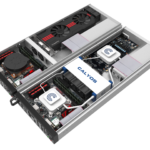In this video from ISC 2017, Olivier de Laet from Calyos describes the company’s innovative cooling technology for high performance computing. “The HPC industry is ever facing is facing the challenge of ever-increasing cooling requirements. While liquid cooling cooling looks to be the best solution, what if you could achieve the same efficiencies without out using water and pumps?”
Calyos Launches Kickstarter for Fanless Gaming PC
Today French Startup Calyos launched a kickstarter funding project for the NSG S0, “the World’s First Fanless Chassis for High Performing PC.” The secret behind the Calyos fanless gaming PC chassis is phase-change cooling through loop heat pipes. Used in Datacenter servers, they absorb the heat from the hot components and move it passively to the edges of the case, where heat can be easily removed with an air or liquid heat exchanger.
Calyos Demonstrates Water Free Cooling at ISC 2016
In this video from ISC 2016, Olivier de Laet from Calyos describes the company’s innovative cooling technology for high performance computing. “The HPC industry is ever facing is facing the challenge of ever-increasing cooling requirements. While liquid cooling cooling looks to be the best solution, what if you could achieve the same efficiencies without out using water and pumps? Enter Calytronics, cooling technology that is as simple as a heat pipe and as performant as liquid cooling.”
Do you like Water? Do you like Pumps?
The HPC industry is ever facing more and more challenges on various topics and especially a significant increase in cooling requirements. To meet those requirements, liquid cooling looks like the solution. But there is an alternative cooling solution that works without a pump and without water.
Innovation Keeps Supercomputers Cool
“The range of cooling options now available is testimony to engineering ingenuity. HPC centers can choose between air, oil, dielectric fluid, or water as the heat-transfer medium. Opting for something other than air means that single or two-phase flow could be available, opening up the possibilities of convective or evaporative cooling and thus saving the cost of pumping the fluid round the system.”








